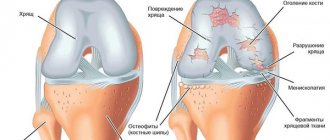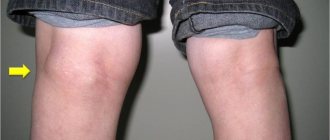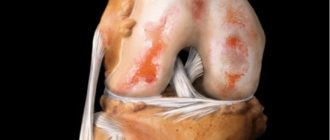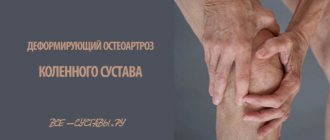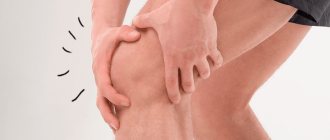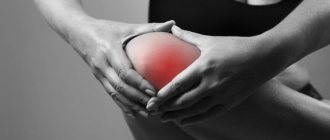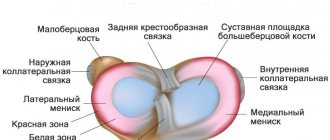From this article you will learn everything about osteophytes of the knee joint: what they are, why they occur, why they are called “marginal”. Are there ways to get rid of them, treatment methods?
Author of the article: Victoria Stoyanova, category 2 doctor, head of the laboratory at the diagnostic and treatment center (2015–2016).
Article publication date: 07/07/2019
Article updated date: 01/16/2020
Osteophytes are growths of bone tissue (most often in the form of spines), which are formed in the joint due to the destruction of articular cartilage and disruption of its functions (degenerative processes).
They are located at the edges of the bony ends of a joint or vertebra, which is why they are also called “marginal osteophytes.”
In the knee joint they occur with arthrosis, starting from stage 2 of the disease. The most susceptible to the appearance of osteophytes in the knee are:
- people of heavy physical labor;
- athletes;
- postmenopausal women;
- older people (both women and men).
The proliferation of osteophytes brings additional pain, which was already present with arthrosis, and also impairs the performance of the joints. Large osteophytes can significantly impede movement in the knee joint, which affects the ability to walk normally.
It is only possible to completely get rid of growths through surgery. But sometimes, if the osteophytes are not very large, conservative treatment is prescribed, which simply helps get rid of unpleasant symptoms and slows down the further growth of spines.
Diagnosis and treatment of patients with spikes in the knee joint are carried out by:
- the same doctor who treats arthrosis is an orthopedist (a broad specialist who deals with diseases of the musculoskeletal system);
- arthrologist (a narrow specialist who works only with joint pathologies);
- sports doctor - if growths arise as a result of playing sports.
On the left is a healthy knee joint, on the right is one affected by osteophytes.
Causes of pathology
Osteophytes are formed during arthrosis, a disease in which the cartilage tissue, which acts as a protection and shock absorber in the joint, becomes thinner. Due to degeneration, that is, due to the destruction of cartilage (or even its complete absence), the bony ends of the joint suffer. They develop abrasions and erosion.
Click on photo to enlarge
Osteophytes begin to grow as a kind of protective reaction of the body. However, it only leads to worsening of the disease, increased symptoms and deterioration of the joint.
Causes of arthrosis that can lead to the growth of “spikes”:
- Excessive loads on the joint - during heavy work, sports, running on a hard surface or wearing shoes whose soles have insufficient shock-absorbing properties.
- Frequent injuries and microtraumas of the knee.
- Age-related changes in the body after 70 years.
- Hormonal changes in women after menopause (lack of female sex hormones leads to loss of elasticity of connective tissues, including cartilage).
- Metabolic disorders.
- Infections.
- Hemophilia - with a blood clotting disorder in the knee, due to microtraumas that are safe for an ordinary person that appear during physical activity, bruises constantly occur, which over time provoke inflammation and destructive processes.
- Previous surgery on the joint - especially if the patient did not follow the doctor’s recommendations during the rehabilitation period.
The risk of developing the disease increases:
- poor nutrition with insufficient intake of microelements (phosphorus, calcium, magnesium, manganese, copper, zinc, selenium) and vitamins (A, E, K, D) needed for cartilage and bone tissue;
- excess body weight, which creates additional stress on the joints (knees in particular);
- frequent hypothermia;
- genetic predisposition to arthrosis.
What it is
Osteophyte is a word that is unclear to most patients. In fact, there is nothing complicated here. Osteophytes are pathological growths of bone tissue where it is normally absent. This condition is not an independent disease, but it accompanies many ailments of the musculoskeletal system. Essentially, this is a compensatory reaction of the periosteum to any adverse effects on the articular joint or the result of fractures.
The growths can have different shapes and sizes. For a long time, due to their small size, they do not cause inconvenience to the patient, but over time they make themselves felt. They often take the form of spikes and hooks.
The process of osteophyte formation is as follows:
- the bone structures of the ankle are deprived of joint fluid, or it becomes insufficient for normal functioning;
- friction increases, surfaces begin to collapse;
- gradually, in places of particularly active friction, compensatory ossifications appear, differing in shape and size from what is needed;
- The bone growth is fully formed.
Osteophyte is not a disease, but the result of a previous injury or other pathology.
Four stages and their signs
At different stages of osteoarthritis, the severity of osteophytes varies:
| Stage | Expressiveness of osteophytes |
| 1 | Absent or not clearly visible There are few of them, they are small in size (1–3 mm) |
| 2 | Already clearly visible on x-ray |
| 3 | Pronounced Medium size (3–8 mm) |
| 4 | Massive growths (8–10 mm or more) Significantly impede movement in the joint |
The four stages of osteoarthritis, osteophytes are marked with red circles. Click on photo to enlarge
Characteristic symptoms
The presence of osteophytes in the knee reveals itself with the following symptoms:
- limitation of the range of motion in the joint, since the spikes create an obstacle to full flexion and extension;
- acute pain that intensifies during physical activity and in the evening after a tiring day at work;
- crunching when moving;
- an increase in the size of the knee (visible in serious stages of the disease);
- change in the shape of the knee (lumpy, uneven contours).
Damage to the knees by osteoarthritis with osteophytes and the formation of varus deformity (O-shaped, in the photo on the left) and valgus (X-shaped, in the photo on the right)
With each stage, the intensity of each sign increases.
If you experience at least one of these symptoms, contact an orthopedist or an even more specialized specialist - an arthrologist.
How to fight osteophytes today
The fight against osteophytes is part of the general treatment regimen for coxarthrosis, gonarthrosis or arthrosis of another joint. It is almost impossible to get rid of bone growths. The goal is to reduce pain and expand the range of motion. For this purpose, depending on the stage of arthrosis, the patient is prescribed:
- ointments to reduce unpleasant symptoms, such as hydrocortisone;
- non-steroidal anti-inflammatory drugs in the form of tablets or injections into the joint;
- physiotherapy - laser, magnets, electrophoresis, shock wave treatment.
One of the physiotherapeutic methods of combating pain due to arthrosis is magnetic therapy. What is it based on and why it helps, says the specialist:
Possible complications
Osteophytes of the knee joint are very dangerous. They can lead to lameness. If the pathological process affects both legs, then walking can be very difficult, and in the later stages, even impossible.
Their presence is fraught with complete immobility of the knee joint due to the following complications:
- Ankylosis of the knee joint (fusion due to the fusion of the upper and lower marginal osteophytes).
- Contracture of the knee joint (fixation in one constant position due to the fact that growths do not allow it to move).
Click on photo to enlarge
Types of osteophytes
In addition to the etiology of osteophytes, the criterion for classifying growths is their location. It not only has implications for the selection of therapeutic measures, but can also give clues about the causes of the pathology.
Osteophytes of the spine
Spinal osteophytes are an integral part of spondylosis
. At these stages, they respond well to treatment with physical therapy and physiotherapy, orthopedic correction (wearing a corset) and drug therapy.
The role of spinal osteophytes is to maintain sufficient distance between the vertebrae. Normally, this function is performed by intervertebral discs - the natural shock-absorbing pads of the ridge. However, with age or under the influence of stress, their height may decrease, which leads to contact between the protruding parts of the vertebrae and compression of the nerve roots. This situation without treatment of spinal osteophytes is fraught with disturbances in tissue trophism and their further destruction. In an attempt to contain the destructive effects, the body builds “protective barricades” in the form of osteophytes with a clearly defined marginal localization.
Signs of osteophytes in the spine are:
- a feeling of stiffness in the spine, especially after sleep or a long stay in one position (patients find it difficult to straighten);
- weakness of the back muscles and a feeling of numbness in some areas along the ridge (so-called clamps);
- back pain when changing position, prolonged standing, certain movements (at first episodic, but can become more and more prolonged; the nature of the pain is stabbing, sharp or pulsating);
- burning and tingling sensation caused by irritation of nerve endings;
- swelling of the back;
- radiating pain;
- changes in gait (especially with twisting of the foot).
Depending on which part of the spine the osteophytes are located in, patients may experience specific symptoms - for example, bowel and urination disorders, sexual dysfunction, numbness and weakness of the upper and lower extremities, tremors in the hands, visual disturbances, surges in blood pressure and other. Sometimes spinal osteophytes are visible under the skin or can be easily felt.
In some patients, the formation of osteophytes in the spine is practically asymptomatic, which makes it difficult to fully assess the prevalence of this pathology. However, doctors are sounding the alarm: the human spine is anatomically poorly adapted to the loads associated with upright posture, and a sedentary lifestyle only aggravates this problem
.
In addition to improving metabolism, when treating spinal osteophytes, it is very important to relieve swelling and inflammation of tissues, since they can lead to complications.
Spinal osteophytes are a common type of osteophyte.
Osteophytes of the knee joint
Three faithful companions of osteophytes in the knee joint are pain
,
impaired mobility
and
joint deformation
(in later stages). People over 40 years of age are especially susceptible to the problem, however, professional dancing and sports, injuries and other factors can shift the formation of growths to an earlier date. As a rule, osteophytes grow on the lateral surfaces of the knee joints and in the periarticular tissues.
Initially, pain due to osteophytes of the knee joint may only appear when standing for a long time or getting up from a seat or bed. Often patients believe that they have failed to stand on their leg, but over time the pain becomes more and more prolonged and background. They are often accompanied by characteristic clicks and a dry, rough crunch. Gradually, the pain becomes intense, intensifies in the evening, and subsequently begins to bother you at any time of the day or night.
In the morning, patients with osteophytes of the knee joint experience characteristic stiffness, which may disappear after warming up. Then the amplitude of voluntary movements is reduced: it becomes difficult for patients to fully bend or straighten the leg at the knee. It becomes hot, swollen and red, which is why patients require constant use of anti-inflammatory drugs
.
If the osteophyte of the knee joint grows in the form of a long thin spike, over time it can break off under stress (for example, when squatting). In this case, a fragment can fall into the joint cavity and completely block it - treatment of osteophyte of the knee joint, which has become the so-called. articular mouse, performed only surgically
.
Remember: at the very beginning (when the size of osteophytes of the knee joint is 1-2 mm), the disease is amenable to local drug treatment, physiotherapy and therapeutic exercises
, so you shouldn’t delay seeing a doctor if you have discomfort in your knees. In the later stages, arthroscopy or endoprosthetics are indicated for the treatment of osteophytes of the knee joint.
Osteophytes of the cervical spine
The formation of osteophytes in the cervical spine often causes postural disorders. Being quite mobile, this part of the spine is quite easily injured, and the vertebrae are displaced. The presence in the tissues of the neck of a large number of nerve endings and large blood vessels, on which the normal functioning of the brain, spinal cord and sensory organs depends, makes even small osteophytes of the cervical spine very dangerous. For the same reason, it is difficult to remove them surgically. Therefore, it is so important to monitor the first symptoms of osteophytes in the cervical spine:
- discomfort in the neck, a feeling that it has become harder for the patient to hold his head;
- feeling of stiffness, tension, especially at the end of the working day or after sleep (patients need a warm-up);
- crunching of the vertebrae, feeling as if they are rubbing against each other;
- increasing difficulty turning the head (may be accompanied by nagging pain);
- a feeling of burning, numbness and tightness in the cervical-collar area;
- the development of inflammation, which is accompanied by edema and local fever.
Patients often complain of secondary symptoms of cervical osteophytes - headaches, increased fatigue, weakness, trembling and numbness in the extremities of the shoulder girdle, impaired vision and hearing, spots in the eyes, arterial hypertension, dizziness, deterioration of cognitive abilities.
Diagnostics
Already during the examination, the doctor may suspect the presence of osteophytes, based on the medical history and characteristic symptoms.
To confirm, an X-ray examination is prescribed - the image will show the spines, their size, shape, number, and location.
Auxiliary diagnostic methods:
- Ultrasound helps determine the condition of the cartilage and see how osteophytes have affected the condition of the soft tissue surrounding the joint.
- Blood tests to identify the possible cause of arthrosis and the resulting osteophytes.
Expensive diagnostic methods - CT or MRI - are not required in most cases, since the spines are clearly visible on a regular x-ray.
X-ray of a knee joint with osteophytes
Patient complaints
Osteophytes are an insidious pathology. For a long period of time they do not remind anyone of themselves. Only when they reach a significant size will the first symptoms appear.
The patient will present the following complaints:
- the appearance of pain in the affected area, which may intensify with movement, sudden uncontrolled actions such as coughing or sneezing, or taking an uncomfortable position;
- negative changes in the mobility of the affected ankle;
- the appearance of crunching, creaking in the affected joint;
- the onset of an inflammatory process in surrounding tissues due to their damage;
- swelling of the problem area.
Ignoring pathological changes leads to a gradual but steady worsening of symptoms. Over time, a person may even become disabled if a diagnosis is not made in time and therapy is not started.
Treatment: conservative, surgical
If the growths are small and do not interfere with normal joint movements, but only cause mild pain at the end of a tiring day, they can be treated conservatively.
If they impede joint movements and pose a danger, they are combated with surgical methods.
The larger and more numerous the growths, the less favorable the prognosis.
Conservative treatment of osteophytes is not so much the treatment of the osteophytes themselves, but rather the elimination of symptoms. The osteophytes themselves remain in the joints. The prescribed treatment prevents their further growth and prevents tissue destruction.
For small osteophytes (1–3 mm) that do not affect the mobility of the knee, conservative methods can be used, but treatment must be carried out continuously.
Large (8–10 mm or more) osteophytes can only be treated surgically.
Conservative therapy
Non-surgical treatment of osteophytes of the knee joint is aimed at eliminating symptoms and preventing the enlargement of the spines.
For osteophytes, the following is prescribed in combination:
- medicines;
- physiotherapeutic procedures;
- therapeutic exercises.
Medicines
For patients with spikes in the knee joints, the doctor may prescribe the following remedies:
| Group of drugs | Effect |
| Nonsteroidal anti-inflammatory drugs (NSAIDs): Indomethacin, Ketoprofen, Diclofenac | Relieve pain syndrome Eliminate inflammation of periarticular tissues, which can be caused by osteophytes |
| Chondroprotectors – in tablets (Teraflex, Chondroxide, Artra) and injections (Dona, Alflutop, Artradol) | Strengthens cartilage tissue Increasing the density and elasticity of cartilage reduces friction between the bony ends of the joint This prevents further bone injury and osteophyte growth as a protective response. Injections directly into the joint protect bone tissue from friction and damage |
| Vasodilators: (Pentoxifylline, Trental, Teonicol) | Helps improve blood supply to cartilage, thereby slowing down its destruction Helps prevent further growth of bone growths along the edges of the joint |
Click on photo to enlarge
Physiotherapy
For osteophytes, physiotherapeutic procedures such as:
- Ultrasound therapy is the effect of ultrasonic waves on the joint. Relieve inflammation, swelling, pain, activate metabolic processes and accelerate tissue regeneration.
- Phonophoresis is the administration of medicinal substances (anti-inflammatory, painkillers) using ultrasound.
- Mud therapy is the application of therapeutic mud to a joint. Eliminate inflammation, relieve pain, accelerate tissue healing.
- Therapeutic baths with sea salt, eucalyptus and cypress oils, pine needles, sage, etc. Relieve inflammation in the joints.
- Diadynamic currents – impact on the sore spot with currents with a frequency of 50–100 Hz. Relieve pain, stimulate muscles, improve blood flow in tissues.
- Galvanic currents are the effect of continuous current on the joints. Reduce inflammation, improve blood supply to tissues.
They help improve blood circulation, so nutrients will be better supplied to the cartilage tissue. This will prevent further destruction of cartilage and even greater growth of osteophytes.
Physiotherapy procedures: 1 – phonophoresis, 2 – mud treatment, 3 – therapeutic bath with sea salt, 4 – diadynamic currents. Click on photo to enlarge
Physiotherapy
Exercise therapy helps prevent mobility problems in the knee joint.
Exercises are selected individually, taking into account:
- stages of arthrosis;
- level of physical fitness;
- general health.
An example of exercise therapy exercises for osteoarthritis. Click on photo to enlarge
Surgery
Osteophytes can be eliminated in several ways. Many of them do not require open access to the joint.
The operation can be performed using arthroscopy - inserting an arthroscope (a device with a camera that visualizes the knee joint) and surgical instruments into the joint through small incisions.
Minimally invasive techniques are less traumatic and therefore do not require as long a rehabilitation period as open joint surgery.
Osteophytes can be removed using arthroscopic techniques (without tissue incision - through small punctures):
- grinding - grinding off tenons;
- arthroplasty – restoration of the normal shape of the joint.
In advanced cases - with large osteophytes that disfigure the joint and greatly impede movement in it, endoprosthetics is required. This is the replacement of a joint damaged by a pathological process with its artificial counterpart. The operation is often performed with open access to the affected area. A substitute is an artificial implant made of polymer materials (ceramics, metal and plastic).
Knee replacement is the most effective, but at the same time the most radical operation. Recovery after such surgery will take about 1.5 months. The patient can then return to everyday life.
Endoprosthesis replacement of a diseased knee joint. Click on photo to enlarge
Is surgery necessary?
If conservative treatment does not help and the patient continues to experience pain, there are two options. Bone formations can be removed surgically. True, this will have to be done regularly, since the problem will not disappear, and osteophytes will continue to form with enviable frequency. Therefore, it makes sense to act radically.
With the help of intra-articular injections of a synovial fluid prosthesis, for example, Noltrexin, it is possible to move the rubbing surfaces apart. Thinning cartilage no longer rubs, and the body does not receive a signal about the need for compensation. Under such conditions, when there is enough synovial fluid, despite damaged cartilage, osteophytes do not form.
Before deciding to have surgery, weigh the pros and cons. Osteophytes in the joints severely limit mobility. But to get it back and get rid of the pain, it is not at all necessary to undergo surgery.
Prevention
To prevent the formation of osteophytes and avoid walking problems requiring surgical intervention, follow a number of recommendations:
- Avoid gaining excess weight - it puts additional stress on the joints of your legs.
- Eat properly and variedly - cartilage and bones should receive all the nutrients they need.
- Don't get too cold.
- Treat knee injuries promptly and correctly, consult a doctor, even if you yourself consider the injury not serious.
- When playing sports: do not put excessive stress on your feet, do not run on hard surfaces (such as asphalt), choose the right shoes in which the sole has high shock-absorbing properties, do not land with your legs straight at the knees, if necessary during increased stress on the knees wear a special bandage or bandage them with an elastic bandage.
- During menopause, undergo hormonal replacement therapy with drugs individually selected by the treating gynecologist.
- At the first symptoms of arthrosis (a feeling of stiffness in the knee, pain), do not delay a visit to a specialist - at stage 1, osteophytes may not yet exist, and if complex treatment is started in time, their formation can be avoided.
Varieties and most common localization
There are 4 main types of these formations.
- Post-traumatic
Mainly affects the lower part of the musculoskeletal system, but can also involve the area of the elbow and wrist. This is explained by the fact that these areas are most often injured even in everyday life not associated with major sports. It is important to remember that bone damage is not a necessary factor in the formation of a growth. A simple rupture of the periosteum is sufficient.
- Periosteal
They develop when there is a constant inflammatory process in the ankle joint area. It is impossible to predict which areas will undergo ossification and how the process as a whole will develop in this case.
- Degenerative-dystrophic
Most often it is a consequence of the development of arthrosis. Accompanied by impaired mobility in the foot area.
- Massive osteophytes
A. b
A. massive osteophytes. b. osteophyte of the talus
Volumetric growths that can even change the configuration of the joint are mainly a consequence of the impact of tumor pathologies on the body.
Additionally, there is a classification of osteophytes based on cellular structure. Highlight:
- spongy defects formed from spongy bone tissue;
- metaplastic defects resulting from a violation of the bone structure;
- compact, formed from the outer layer of bone, affecting mainly the area of the feet and fingers;
- cartilaginous, appearing under excessive loads instead of cartilaginous tissue.
The growths can be localized on any joint of the human body. Most often the elbow joint, knee area, hip joint, spinal column, and ankle are affected.

